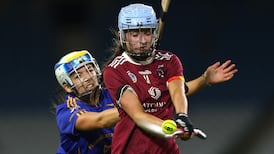In a thoughtful contribution in these pages last week Feargal McGill, the GAA’s head of games administration, set out what he felt were the reasons for poor attendances this season.
Among the reasons cited were the paucity of competitive matches and the lack of optimism among so many counties, especially in Leinster, and also the need for new, emerging counties to stake a claim in the championship.
Last weekend delivered some of the required remedies, as a second tranche of football quarter-finals materialised in sufficiently appetising form for Croke Park to be probably full or close to capacity next Saturday. We also had a county reach the semi-finals for the first time in 81 years.
Panicky
Sometimes during a championship season it can be hard not to resemble the people on comedy boats, whose panicky rushing between port and starboard makes the vessel list one way and then another as each successive alarm drags them this way and that.
At the start of the season there were going to be no surprises – until the one weekend that saw Tipperary's footballers beat Cork after a gap of 72 years and then Galway defeating Mayo for the first time in what seemed even longer. Aidan O'Shea shook his head the following Monday and said that he had never lost a championship match against Galway at any grade. Ever.
Then Galway became – along with accomplices Roscommon – the latest defilers of football before turning into the very essence of its modern practitioners seven days later: meticulously organised at the back and swift and admirably lethal in attack.
A week later their pathway to a first All-Ireland semi-final in 15 years appeared to de-complicate when Tipp beat Derry in a qualifier round that added two new counties to the list of Munster sides to have reached the last eight.
We all know what happened next in the championship fortunes of Galway and Tipperary, who had coincidentally emerged on that same weekend, half way through June.
The Connacht champions with their sprinkling of underage All-Ireland winners but short of the 52 players who, according to manager Kevin Walsh, had declined to get involved with the county, were flattened by outsiders with a sprinkling of underage All-Ireland winners but short the 13 players from last year's team, who were no longer available to Liam Kearns.
It’s easy to forget that Tipperary is a big footballing county. It has history and tradition, albeit earned in the sepia days of the GAA’s early years during which they had amassed four All-Irelands by 1920, at that stage putting the county fourth on the roll of honour.
Their footballers were party to one of the GAA’s iconic events when their challenge match with Dublin in November 1920 ended up in massacre on Bloody Sunday. More to the point, they have, in modern times, begun to pick up underage – and club – silverware at provincial and All-Ireland level.
Dreary mantras
For all that and the dreary ‘we got no respect or not enough credit’ mantras – would it make that much difference for teams who have won matches as underdogs just to celebrate their achievement? I imagine few enough people would have gone around Tipperary on Sunday had they lost, saying, ‘told you, you wouldn’t win’ – this was a major surprise.
It was helped along by Galway being the least experienced of the provincial champions and their performance being in line with the most pessimistic projections before they had played Mayo; but, unlike so many underdogs, Tipp had confidence and a gameplan, as well as some exceptional individual performances.
One very good indicator of a shock – although not the only one – is the attendance. Fewer than 10,000 were present when Offaly beat Kilkenny to win their first Leinster hurling title 36 years ago. Had more people expected them to win, the crowd would presumably have been bigger.
Sunday’s crowd for the first appearance of both Clare and Tipperary in the last eight of the All-Ireland football championship was 29,251, the second lowest in 16 years of quarter-finals at Croke Park.
Tipperary's achievement is on a par with that of Fermanagh and Wexford, who also reached the All-Ireland semi-finals in 2004 and '08 respectively. And coincidentally, they'll play either Mayo, who were Fermanagh's opponents 12 years ago, or Tyrone, who were Wexford's.
Milestone
Those semi-finals represented a destination rather than a milestone for both counties but Tipp have more solid foundations, even if they will need to get back a good few of those 13 absentees if they are to build on this in seasons to come.
When discussing the woes of the championship, McGill wisely made no reference to the poor quality of football. It’s become a fashion now to ascribe falling crowds to overly defensive tactics, as if the GAA spectating public had suddenly become aesthetes as opposed to fiercely motivated partisans.
He was quite right: there’s just one thing that gets the crowds out and that’s the team’s prospects of winning something. Mind you, as Dublin are discovering, if you win too much too easily that doesn’t help either.
If bricked-up defences were an issue, how did the recent Ulster final have its best attendance of the last four years? If the sheer spectacle of having a go is such an allure, why are Dublin's audiences falling in Leinster and why weren't there more in Croke Park to see a Tipperary side averaging over 0-20 a match?
There remain concerns about falling crowds and sadly, last weekend didn't invalidate them. smoran@irishtimes.com











